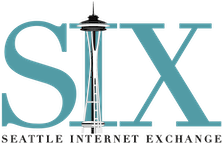The Seattle Internet Exchange exists as a cooperative effort and the following rules ensure the short and long term health of the exchange fabric:
- Peering is bilateral with the exception of route servers. There is no Multi-Lateral Peering Agreement (MLPA).
- Participants must use BGP-4 or its successor and must set NEXT_HOP_SELF if advertising routes from other SIX participants.
- Participants may not point default or otherwise use another participant's or SIX's resources without permission.
- There are only three ethertypes allowed: 0x0800 (IPv4), 0x0806 (ARP),and 0x86dd (IPv6).
- The only non-unicast traffic allowed is broadcast ARP and multicast ICMPv6 Neighbor Discovery packets. Per-neighbor timeouts that result in flooded (broadcast/multicast) packets should be set to 4 hours or as close to that as able in the case of vendor limitations. Short timeouts may result in quarantine.
- Participant ACLs must not violate neighbor discovery norms, since doing so will result in excess flooded packets on the community fabric and burden for SIX administrators. For IPv4 this means that a participant's router must be configured to receive and respond to ARP packets from all SIX participants, even those that are not direct peers. For IPv6, this means that participant routers must receive and respond to ICMPv6 neighbor solicitation packets from both fe80::/10 and all SIX participant addresses, including those that are not direct peers, directed toward fe80::/10, ff02::1:ff00:0/104, and the participant's unicast SIX assignments. Pseudo-ACL examples of this are available in the SIX FAQ.
- Participants must not allow SIX subnets to propagate externally from their network and should minimize internal propagation as much as able. If a participant's network beyond their SIX edge router(s) can reach the SIX subnet addresses, ACLs are requested in order to prevent this.
- Participants may not sniff traffic between other participants.
- Participants must be responsive to other participants and SIX administrators in order to protect the short and long term health of the exchange fabric. Urgent issues may result in suspension of a participant in order to protect the fabric. For non-urgent issues, if a participant is unresponsive to concerns raised by a SIX administrator, a SIX administrator will notify the non-responding participant via their PeeringDB and SIX contact emails, of their need to respond in order to avoid suspension from the SIX. The length of time to determine if a participant is unresponsive, and time to suspension, will depend on the severity of the matter, each not to exceed two weeks.
Press Release Policy:
- If your organization plans to release press releases specifically mentioning the Seattle Internet Exchange, please coordinate with the SIX administrators as a courtesy prior to doing so. Emailing to info_a_t_seattleix.net is the best method of contact. In addition, please keep in mind that SIX participation does not grant organizations any rights to use other participants' names, logos, or other information.
Switch Interconnection (Extension) Policies:
- Participants may only utilize a single layer-2 MAC address to place a single layer-3 router per port allocated from the SIX switch fabric unless by prior agreement of the board. The procedure for interconnecting with the SIX with more than one ethernet MAC address on a single port or LAG is as follows: a technical proposal shall be made to the board, accompanied by full documentation. This documentation shall be published on the announcement mailing list and the SIX web site for comment by the participants and the public for a period of no less than two weeks, whereupon the board shall determine whether the operator is allowed to perform the proposed interconnection. No more than one such proposal shall be entertained at a time, and any subsequent modifications to the interconnected equipment shall be similarly approved by the board. The operator shall be responsible for maintaining any required documentation of all layer-2 devices comprising the switch fabric, and such documentation shall always be available to SIX administrators.
- Whereas extension operators have certain responsibilities toward their users and the community at large, and whereas industry standard 5-minute sampling techniques mask microbursts of traffic:
- Extension circuits peaking above the upgrade threshold of 66% utilization (5-minute sample) should work with the SIX administrators to have capacity increased to bring peak utilization under the upgrade threshold. The cost for upgrades is to be borne by the extension operator.
- The connection procedure for new participants on an extension will include ensuring that month peak utilization is below the upgrade threshold.
- The SIX administrators will notify an extension when additional capacity is needed, but extension operators should also monitor their utilization and be proactive.
- If an extension circuit peaks above the notification threshold of 80% utilization, or if there is active packet loss, the SIX administrators will notify the participants on the extension so they may mitigate traffic as appropriate for their network.
